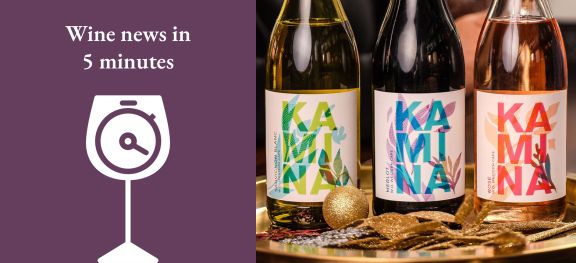What the US elections mean for the wine industry, defining old vines, UK duty hike response

Plus an update on the floods in Spain and reminder of our ongoing 2023 Rhône coverage. Above, the new low-alcohol wines created to skirt the UK duty hikes.
Before I get underway, I want to shout-out the reports on the newly released 2023 vintage from the northern Rhône by James Lawther MW. James has published four articles on JancisRobinson.com this week to assist anyone looking to stock their cellars when these wines are offered for purchase later this year and early next year.
Flood update from Spain
On the heels of last week’s news on the devastating flash floods in eastern Spain – which caused 219 deaths and destroyed thousands of homes and thousands of hectares of fruit and vegetable plantings – the Spanish government has pledged €10.6 billion in aid to families, businesses and town halls. The regional government of Valencia has requested a further €31 billion in aid. The 2024 wine harvest was spared, as all the grapes were in before the rains began, but our Spanish correspondent Ferran Centelles reports that some vineyards have been damaged due to landslides, damaged trellises and other structural issues. If you are in NYC this weekend, stop by Despaña on Saturday or Sunday, 1–5 pm, where all proceeds from a special menu will be donated to World Central Kitchen and Cáritas Valencia.
Wine under Trump
The US presidential election took place on Tuesday 5 November and Donald Trump was declared the next president of the US early Wednesday morning.
Trump will not be sworn in until Inauguration Day on 20 January, but he has made a number of promises – many which will impact the wine industry.
During his campaign Trump promised to impose a 60% tariff on all Chinese goods and at least a 10% tariff on all other imports. While we obviously can’t be sure of anything, if history is any indication, this is likely to happen. In 2019, as the result of an ongoing dispute concerning EU Airbus subsidies, Trump implemented a 25% tariff on French, German, UK and Spanish wines under 14% alcohol. In 2020, he widened that to include all French and German wines over 14% alcohol as well as pretty much every dairy product in the EU. The tariffs were suspended by the Biden administration in June 2021.
Unless you are a US citizen who drinks only US wines and is in no way involved in the wine industry, tariffs on imported wine are bad news. The US is the world’s largest wine importer by value and imports wine from almost every wine-producing country. Of the 1.84 million Americans who are employed in the US wine industry, 719,198 – or 39% - of them are employed in wholesaling or retailing and make a large part of their living selling international wines. Tariffs like the ones proposed do not affect just foreign wine producers – they affect the truck drivers, warehouse workers and restaurant servers employed in transporting, stocking and serving international wine. They also raise prices for consumers. And there is a real possibility of retaliatory tariffs that would affect US wine producers.
Trump has also vowed to deport a record numbers of immigrants. 44% of farm labourers in the US do not have US citizenship. 41% of crop (as opposed to livestock) labourers do not have legal authorisation to work in the US. If those people are deported, quite apart from it wildly disrupting their lives, and the lives of the communities they live in – not just the places where they work but also the grocery stores they shop in, the restaurants they frequent, the businesses they support – the US’s capacity for agricultural production – of any sort – goes down and labour prices go up – which will, in turn, raise prices on domestic wine and food.
De-alcoholising wine to skirt UK duty hikes
Last week I made mention of the UK duty escalator that will go into effect in February 2025. When that happens alcohol duty will rise with every 0.5% increase in alcoholic strength starting at 8.5%.
This week the UK’s largest independent drinks wholesaler, LWC, announced that they had partnered with South African winery Overhex Wines to launch a brand called Kamina which will produce Sauvignon Blanc, Rosé and Merlot at 8% alcohol by de-alcoholising wine and then blending it back with the original wine to hit 8%.
To me this seems ridiculous. Not for LWC and Overhex – innovation is to be expected, and this is a smart financial move. No, it’s ridiculous that a product whose alcohol naturally reaches a certain level based on the ability of its raw product – grapes – to achieve high sugar levels – is being forced to undergo insanely manipulative, energy-intensive de-alcoholisation in order to make it more competitive in a struggling market. If you’re wondering how one even goes about de-alcoholising wine or why anyone would choose to do it (other than this absurd new system the UK government has implemented) I highly recommend reading Julia Harding’s article on the subject – which I’ll link to in the transcript of this newscast.
How old is 'old vine'?
In 2010, Jancis and Tam started a spreadsheet recording old-vine vineyards around the world. That eventually grew into The Old Vine Registry, an online database of old-vine vineyards. This database, in tandem with South Africa's Old Vine Project, The Old Vine Conference and Italy’s Censimento Vecchie Vigne, have inspired the OIV (International Organisation of Vine and Wine), an intergovernmental organisation that deals with technical and scientific aspects of viticulture and winemaking and gathers data across its 50 member states, to pass a resolution defining ‘old vine’ and ‘old-vine vineyard’. The official definition of an ‘old vine’ is now ‘a single plant officially documented to be 35 years or older regardless of any other factors … An old vineyard is a block of vineyard terrain, continuous and legally delimited, where at least 85% of the grapevines respond to the previous definition.’
Perhaps this seems like semantics but as Tam pointed out to me this morning, having an official definition opens up the possibility of procuring EU funding for research on old-vine vineyards, possible legal protections and a greater interest in tracking and collecting data.
You can read the entire Resolution OIV-VITI 703-2024 here.
That’s all for this episode of the wine news. If you enjoy this newscast and would like to see it continue, please subscribe to JancisRobinson.com. And if you have breaking news in your area, please email news@jancisrobinson.com.
This is a transcript of our weekly five-minute news broadcast, which you can watch below. You can also listen to it on The Wine News in 5 Podcast. If you enjoy this content and would like to see more like it, please subscribe to our site and our weekly newsletter.
Become a member to view this article and thousands more!
- 15,409 featured articles
- 275,057 wine reviews
- Maps from The World Atlas of Wine, 8th edition (RRP £50)
- The Oxford Companion to Wine, 5th edition (RRP £50)
- Members’ forum
- 15,409 featured articles
- 275,057 wine reviews
- Maps from The World Atlas of Wine, 8th edition (RRP £50)
- The Oxford Companion to Wine, 5th edition (RRP £50)
- Members’ forum
- 48-hour preview of all scheduled articles
- Commercial use of our wine reviews
